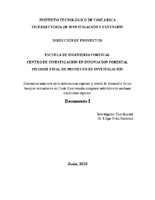Derivación indirecta de la distribución espacial y estado de desarrollo de los bosques secundarios en Costa Rica usando imágenes satelitales de mediana resolución espacial. Documento I

View/
Date
2020-06Author
Ortiz-Malavasi, Edgar
Soto-Montoya, Casia
Aguilar-Arias, Heileen
Miller-Granados, Cornelia
Ávila-Pérez, Iván
Vargas, Yerlin
Metadata
Show full item recordAbstract
El objetivo de la presente investigación fue desarrollar una técnica indirecta para conocer la
distribución espacial y estado de desarrollo de bosques secundarios usando sensores
remotos de mediana resolución. La metodología fue probada en un sector de la Zona Huetar
Norte de Costa Rica. Se realizó la clasificación de imágenes satelitales Landsat y Sentinel-2
de diferentes años: 2000, 2005, 2010 y 2017/2018. Se comparó la ubicación de las masas
boscosas por año y se efectuó una reclasificación de las áreas donde se presentó ganancia
de cobertura arbórea (bosques nuevos) identificándose cuáles de estas representan bosques
secundarios. Se validaron los resultados y las exactitudes obtenidas se utilizaron como
variables respuesta de un ANOVA. El método OBIA supera a MLC en la identificación de
los bosques nuevos (pvalue=0,035). El mes de la imagen influye en la exactitud del
productor ya que produce una interacción con el método (pvalue= 0,027) y con el tipo de
imagen (pvalue= 0,008). También se produce una interacción mes-imagen para la exactitud
del usuario (pvalue= 0,042) y la exactitud general de la clase de bosques secundarios
(pvalue= 0,012). La tendencia muestra que el mejor método para cuantificar y ubicar los
bosques secundarios es la clasificación de imágenes Sentinel-2 de los meses de junio y julio
mediante Análisis Basado en Objetos (OBIA). The objective of the present investigation was to develop an indirect technique to know the
spatial distribution and development status of secondary forests using medium resolution
remote sensors. The methodology was tested in a sector of the Northern Huetar Zone of
Costa Rica. Landsat and Sentinel-2 images were classified for different years: 2000, 2005,
2010, 2017, and 2018. The location of the forest stands per year was compared and a
reclassification of the areas where there was a gain in tree cover (new forests) was carried
out, identifying which of these represent secondary forests. Results were validated and the
accuracies obtained were used as ANOVA response variables. The OBIA method
outperforms MLC in identifying new forests (pvalue = 0.035). The month of the image
influences the accuracy of the producer since it produces an interaction with the method
(pvalue = 0.027) and with the image type (pvalue = 0.008). A month-image interaction also
occurs for user accuracy (pvalue = 0.042) and overall accuracy of secondary forest class
(pvalue = 0.012). The trend shows that the best method to quantify and locate secondary
forests is the classification of Sentinel-2 images for the months of June and July using
Object Based Analysis (OBIA).
Description
Proyecto de Investigación (Código: 1401-0077) Instituto Tecnológico De Costa Rica. Vicerrectoría De Investigación Y Extensión (VIE). Dirección de Proyectos. Escuela de Ingeniería Forestal. Centro de Investigación en Innovación Forestal (CIF), 2020

